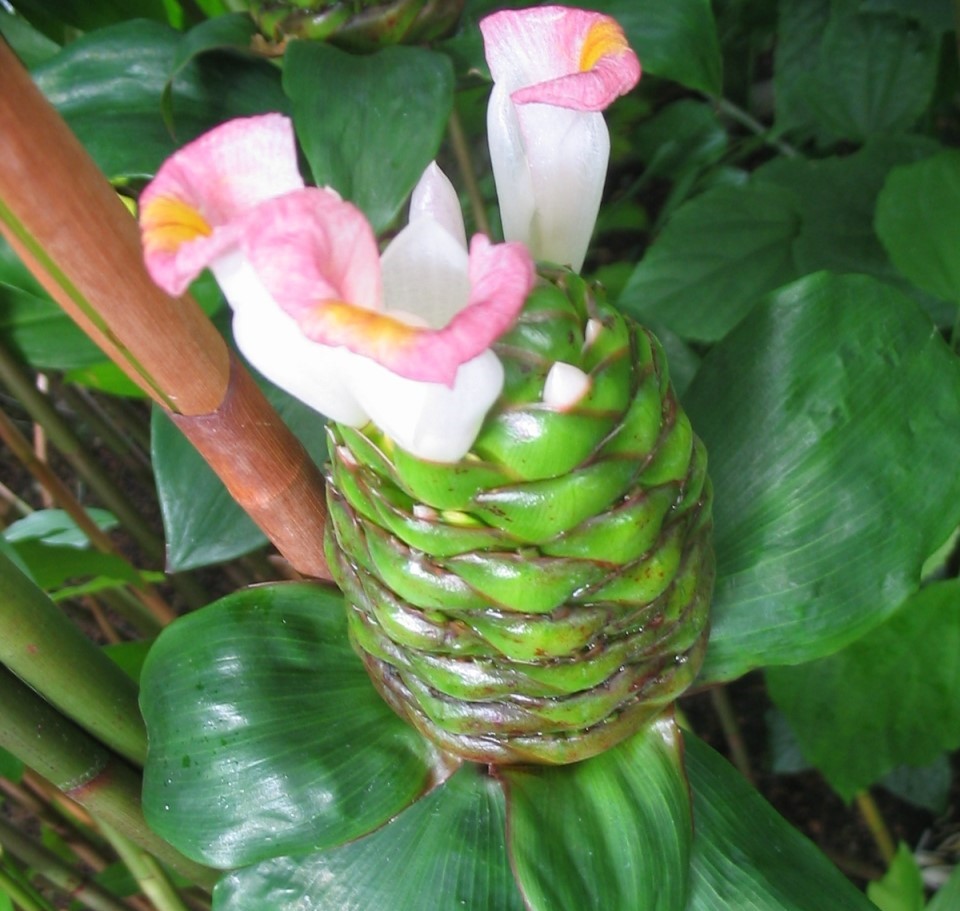Costus afer

|
|
Costus afer Common Names: Ginger lily, Spiral ginger, Bush cane,
Monkey sugar cane Scientific
Classification Kingdom: Plantae Clade: Angiosperms Clade: Monocots Order: Zingiberales Family: Costaceae Genus: Costus Species: C. afer Synonyms: Costus anomocalyx K.Schum., Costus bingervillensis A.Chev., Costus deistelii K.Schum., Costus edulis De Wild. & T.Durand, Costus insularis A.Chev., Costus megalobractea K.Schum., Costus oblitterans K.Schum., Costus pterometra K.Schum., Costus sarmentosus Bojer, Costus subbiflorus K.Schum., Costus trachyphyllus K.Schum., Costus ulugurensis K.Schum. Morphological Description Costus afer is
a tall, perennial, rhizomatous herb reaching 1–4 meters, characterized by its
semi-woody, spirally arranged stems. Its key features include: · Stem: Leafy, erect, unbranched, green, and succulent, often used
for weaving or as a paper source; contains sap with rubefacient and anodyne
properties. · Leaves: Elliptic to lanceolate (15–30 cm × 5–10 cm), dark green,
glossy, with a sheathing base; arranged spirally around the stem. · Flowers: White with yellow markings, borne in terminal, cone-like
inflorescences (5–10 cm long); each flower has a single labellum and is
pollinated by insects. · Roots and Rhizomes: Thick, creeping rhizomes with fibrous
roots; used medicinally for their bioactive compounds. Distribution and Habitat Costus afer is
widely distributed across tropical Africa, thriving in specific ecological
niches: · Geographic Range: Native to West and Central Africa, from
Senegal to Nigeria, Cameroon, Gabon, Democratic Republic of Congo, and Fernando
Po; cultivated in home gardens in Nigeria and Ghana. · Habitat: Prefers moist, shaded environments such as forest
understories, riverbanks, swamps, and secondary forests; tolerates annual
rainfall of 1,200–2,500 mm and elevations up to 1,000 m; often a weed in rice
fields in Nigeria. · Ecological Role: Contributes to soil stabilization in
wetlands; its flowers support pollinators like bees and butterflies; can become
invasive in disturbed areas Ethnopharmacology Costus afer,
commonly known as bush sugarcane or African spiral ginger, is a widely used
medicinal plant in West and Central African traditional medicine. Its rhizomes,
stems, leaves, and roots are known for antidiabetic, anti-inflammatory,
antioxidant, antimicrobial, diuretic, hepatoprotective, nephroprotective, and
wound-healing properties. Traditionally, the plant is used to manage diabetes,
hypertension, cough, malaria, fever, rheumatism, and gastrointestinal
disorders. The stem juice is particularly popular for lowering blood sugar levels
and treating urinary tract infections, while the leaves are applied to sores
and inflammatory swellings. Phytochemical studies have shown the presence of
flavonoids, saponins, alkaloids, glycosides, and phenolic compounds, which
contribute to its medicinal efficacy. Although widely used in ethnomedicine,
scientific validation and standardization of Costus afer preparations are
ongoing to ensure safe and effective clinical use. ·
Anti-inflammatory: In Nigeria, leaf extracts treat
rheumatism. Hexane leaf fractions (100–400 mg/kg) reduced paw edema by 60% in
carrageenan-induced rat models, with IC50 values of 33.36 μg/mL for protein
denaturation, linked to kaempferol glycosides (Anyasor et al., 2014). ·
Analgesic: In Cameroon, stem sap relieves pain.
Ethanolic leaf extracts (1200 mg/kg) increased pain latency by 50% in acetic
acid-induced writhing tests in mice, comparable to indomethacin (Anaga &
Asuzu, 2004). ·
Antimalarial: In Gabon, sap is used for malaria.
Molecular docking studies showed phytochemicals like aferoside C and nerolidol
with high binding affinities to SARS-CoV-2 Mpro, suggesting potential
antimalarial activity (Jannat et al., 2021). ·
Antidiabetic: In Nigeria, rhizome extracts manage
diabetes. Methanol leaf extracts (IC50: 5.99 mg/mL) inhibited α-glucosidase,
reducing blood glucose by 30% in alloxan-induced diabetic rats at 3 g/kg,
comparable to glibenclamide (Ezejiofor et al., 2017). ·
Antimicrobial: In Nigeria, leaf extracts treat
infections. Ethanolic extracts showed MIC values of 250 μg/mL against Staphylococcus
aureus,
validating wound-healing applications (Anaga & Asuzu, 2004). ·
Hepatoprotective: In Cameroon, rhizomes protect liver
function. Aqueous stem extracts (3 g/kg) reduced serum ALT by 45% in
CCl4-induced liver damage in rats, due to antioxidant flavonoids (Ezejiofor et
al., 2017). ⚠ Toxicity Profile: Costus afer is generally safe at therapeutic doses,
but high doses (>3 g/kg) may cause toxicity. Leaf extracts reduced
hemoglobin and RBC counts in rats, suggesting potential anemia with chronic
use. Abortifacient effects were observed in pregnant rats, contraindicating use
during pregnancy. No acute toxicity (LD₅₀ > 5,000 mg/kg) was noted in mice,
but long-term use may elevate liver enzymes (ALT increased by 20% after 60
days) (Health Guide NG, 2021; Udem & Ezeasor, 2010). Additional Uses · Culinary: Young shoots and stems are cooked as vegetables or added to
soups in Nigeria and Cameroon, valued for their mild flavor. · Ornamental: Cultivated for its attractive white-yellow flowers and lush
foliage in tropical gardens; popular in landscaping. · Industrial: Stems are woven into mats and baskets in Benin; sap
coagulates rubber, and stems are explored as a paper source. References
External Links More Pictures |
|
| Compounds of Costus afer | |
| References |